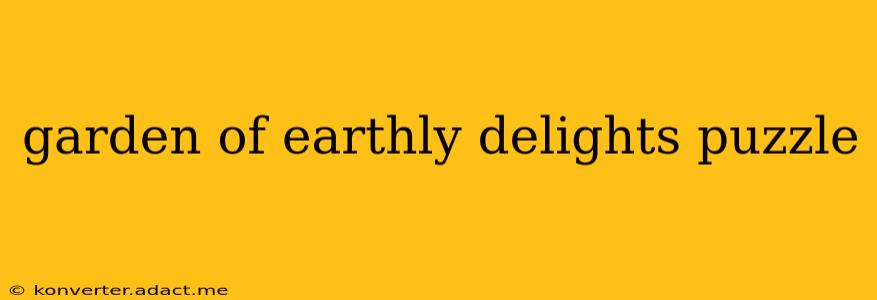Hieronymus Bosch's Garden of Earthly Delights triptych is less a puzzle to be solved and more a riddle to be pondered. Its intricate details, bizarre creatures, and ambiguous symbolism have captivated and confounded art historians and viewers for centuries. This isn't a puzzle with a single correct answer, but rather an exploration of meaning layered within a breathtakingly strange and beautiful work of art. This post delves into the various interpretations and common questions surrounding this masterpiece.
What is the meaning of the Garden of Earthly Delights?
This is the central question, and unfortunately, there's no single definitive answer. Bosch painted during a time of significant religious upheaval, and his work reflects the anxieties and contradictions of his era. Many interpretations exist, ranging from allegorical representations of human nature and the consequences of sin to critiques of societal structures and even proto-surrealist visions.
Some scholars see the left panel, often called the "Garden of Eden," as a depiction of paradise, highlighting the harmony between humans and nature. The central panel, the "Garden of Earthly Delights," is generally interpreted as a depiction of the temptations and excesses of human indulgence, contrasting sharply with the serene simplicity of the left panel. The right panel, often labeled "Hell," vividly portrays the consequences of unchecked desire and sin. This interpretation aligns with a broadly religious framework, showcasing the fall from grace and subsequent damnation.
However, other interpretations exist that challenge this strictly religious reading. Some argue that the work is a commentary on the hypocrisy of religious institutions or a critique of the perceived decadence of the wealthy. The fantastical creatures and landscapes could be seen as allegorical representations of human vices or psychological states. The ambiguity of Bosch's work is part of its enduring appeal; it invites multiple interpretations and continues to spark debate.
What are the symbols in the Garden of Earthly Delights?
The triptych is brimming with symbols, many of which remain debated. Here are a few examples:
- The Egg: In the left panel, a large egg is often interpreted as a symbol of the creation or the potential for life.
- Strange Creatures: The central panel is populated with bizarre hybrid creatures, often seen as representations of human vices or the unpredictable nature of the earthly realm.
- Musical Instruments: The presence of musical instruments in the central panel could symbolize earthly pleasures and sensuality.
- The Fountain: The prominent fountain in the central panel might represent the source of life or pleasure, but also potentially the source of corruption.
- The Transparent Figures: The strange, transparent figures that appear in some of the scenes defy easy interpretation, adding to the overall mystery.
What is the significance of the different panels?
As mentioned earlier, the triptych is divided into three distinct panels:
- Left Panel (Paradise): Often interpreted as depicting the Garden of Eden, illustrating a harmonious relationship between humans and nature in a state of innocence.
- Central Panel (Earthly Delights): This is the most complex and debated panel, showing human indulgence in earthly pleasures, often interpreted as a depiction of the consequences of the fall from grace.
- Right Panel (Hell): This panel offers a terrifying vision of hell, depicting the punishments inflicted upon sinners, highlighting the consequences of unchecked desire and sin. The grotesque imagery serves as a powerful warning.
Is the Garden of Earthly Delights a warning?
Many interpret the Garden of Earthly Delights as a moral warning against the excesses of human desire and the consequences of sin. The stark contrast between the peaceful paradise of the left panel and the chaotic hell of the right panel supports this interpretation. The central panel serves as a powerful depiction of the seductive nature of temptation and the potential for self-destruction. However, it's important to note that Bosch's work is not simplistic; it presents a complex and multi-layered commentary on human nature, rather than simply a straightforward moral lesson.
What makes the Garden of Earthly Delights so famous?
The fame of The Garden of Earthly Delights stems from several factors:
- Its Unparalleled Visual Style: Bosch's unique and fantastical style, unlike anything seen before or since, is immediately striking.
- Its Ambiguity and Mystery: The triptych's lack of straightforward meaning invites endless interpretation and debate, stimulating ongoing scholarly discussion.
- Its Enduring Relevance: The themes explored in the artwork – human nature, temptation, and the consequences of our actions – remain profoundly relevant centuries later.
- Its Artistic Influence: It has inspired countless artists and writers, proving its lasting influence on the world of art and imagination.
The Garden of Earthly Delights is not a puzzle with a single solution. It's a complex and enigmatic masterpiece that continues to challenge and fascinate viewers, offering endless opportunities for interpretation and analysis. Its enduring legacy lies in its capacity to stimulate thought, spark debate, and capture the imagination.
